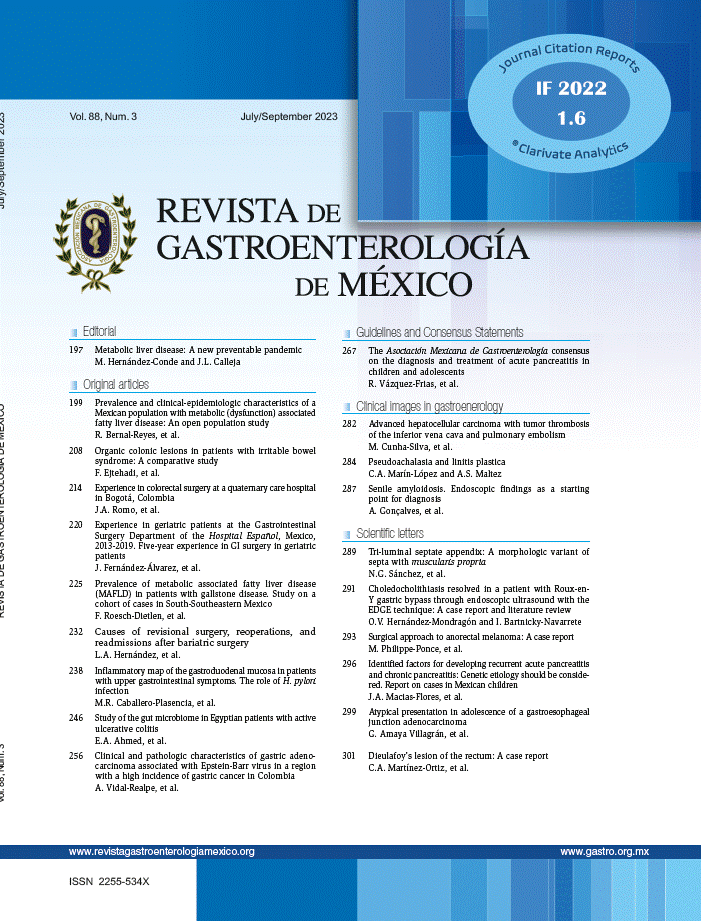Bile acid malabsorption (BAM) is a diagnostic and therapeutic challenge in patients with chronic diarrhea, particularly in those with diarrhea-predominant irritable bowel syndrome (IBS-D) or functional diarrhea.1 The study by Mendoza-Domínguez et al.2 opportunely addresses this problem, exploring the usefulness of the serum 7αC4 biomarker in the detection of BAM, compared with the fecal bile acid (BA) test that measures the levels of BAs in excreted stool over a 48-hour period. Their study not only provides relevant clinical evidence but also underlines the practical and economic limitations associated with current diagnostic methods in Mexico.
The 75SeHCAT test has traditionally been the gold standard for diagnosing BAM.3 However, its lack of availability in many countries, including Mexico, has driven the search for practical and accessible alternatives. The study by Mendoza-Domínguez et al.2 addresses this need in their analysis of 48 patients with chronic diarrhea, evaluated with serum 7αC4, and in some cases, fecal BAs. Their findings indicate that 7αC4 is a reliable biomarker for BAM screening, showing a significant correlation with total bile acid (TBA) levels, albeit a lower one with the primary bile acids (PBAs). In addition, their results underline the fact that 7αC4 levels can be elevated, even in patients with normal TBAs and PBAs, positioning serum 7αC4 as a useful diagnostic tool and one that is more economically accessible.
The ambispective design of the study enables a robust evaluation of retrospective and prospective data, offering a broad panorama on the clinical application of the biomarkers analyzed. Relevantly, the diagnosis of BAM based on 7αC4 had a prevalence of 12.5%, whereas the use of fecal methods resulted in higher rates, especially with PBAs (38.9%). This discrepancy highlights the possibility of underdiagnosis by depending on a single biomarker and underlines the need for combined focuses in selected cases.
The main advantage of 7αC4 use lies in the fact that it is easily obtained through a blood sample, compared with the laborious collection of stools over a 48-hour period. In addition, it represents a 49% savings in costs associated with the diagnosis, a crucial factor in environments with limited resources. Nevertheless, the technique requires specialized equipment for the analysis and can be subject to circadian variations, possibly affecting accuracy in certain contexts.
The study also points out the possibility of false positives or negatives in patients with liver diseases or those being treated with statins, suggesting the necessity for a careful evaluation of the patient’s clinical history before interpreting the results. Furthermore, even though there was a significant correlation between 7αC4 and TBAs, it was not significant with PBAs, which could limit the test’s application in some cases.
BAM has been identified as a frequent but underdiagnosed cause of chronic diarrhea, with significant prevalence in patients with a history of cholecystectomy and patients with IBS-D.4 In their study, the authors found that close to half of the patients seen for chronic diarrhea (46%) had a history of prior cholecystectomy, and of those patients, 23% presented with BAM in the screening test, compared with 4% that did not have that surgical history. Those findings confirm the results of previous studies conducted in Mexico, in which cholecystectomy was a risk factor for chronic diarrhea, especially in patients with IBS-D (odds ratio 2.9, 95% confidence interval 2.3-4.4).5 This result reinforces the hypothesis that the alteration in the bile acid enterohepatic cycle following surgery can predispose to BAM.
BAM has recently been proposed to be a “novel” etiopathogenic factor in patients with IBS-D, especially in patients that do not respond to conventional treatments.6 With that in mind, a pathophysiologic approach to those cases should be a routine evaluation with screening tests, such as that proposed by the authors, for ruling out idiopathic BAM (type 2). Strikingly, only one case of BAM was found in the patients with IBS-D, thus reporting a lower prevalence than that described in other case series (4%). For example, in a recent systematic review, up to one-fourth (28%) of the patients with IBS-D were calculated to have BAM.7 Stated as limitations in their study, selection bias or the lack of clinical suspicion could most likely explain said lower prevalence.
This study opens the door for the implementation of 7αC4 as the first step in the diagnostic algorithm for BAM, especially in patients with a history of cholecystectomy or functional diarrhea that is refractory to conventional treatment. However, it also emphasizes the importance of combining serum and fecal biomarkers in complex clinical situations or when initial results are doubtful. In the future, it would be valuable to conduct studies with larger sample sizes and evaluate combinations of biomarkers, to optimize diagnostic accuracy. Likewise, the possibility of implementing simplified tests, such as BA measurement in single stool samples could facilitate the diagnosis and management of BAM even more.
In summary, the study by Mendoza-Domínguez et al.2 provides solid evidence for considering the use of 7αC4 as a viable diagnostic tool for BAM in clinical practice. Their findings highlight the need for accessible and cost-effective methods for approaching this underdiagnosed condition and improving the management of patients with chronic diarrhea. This study represents a significant step toward a more efficient and accessible diagnosis of BAM in contexts where access to traditional methods is limited.
I cannot conclude this editorial without making an emphatic call to laboratories and diagnostic centers to intensify efforts and implement these tests in our country. This could enormously benefit patients with IBS, especially those with the diarrhea subtype. Possibly up to 30% of our patients diagnosed with “nervous colitis” (sic) actually have an underestimated organic condition, and as a result, do not receive adequate and specific treatment.
Financial disclosureNo financial support was received in relation to this article.



